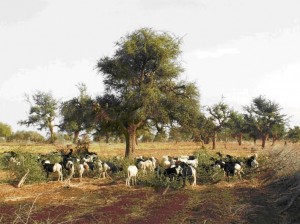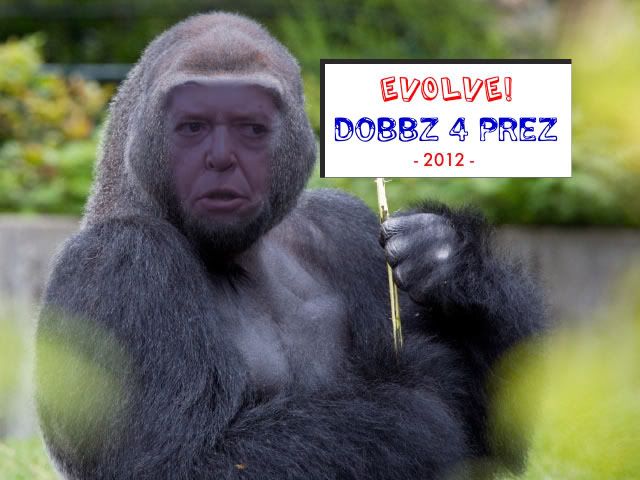Originally featured in the Montreal Gazette. Cross posted from Border Jumpers, Danielle Nierenberg and Bernard Pollack.
 I grew up in Westmount as an only child with a relatively privileged middle-class life. I attended Selwyn House elementary, and we had season tickets to the Canadiens at the old Forum.
I grew up in Westmount as an only child with a relatively privileged middle-class life. I attended Selwyn House elementary, and we had season tickets to the Canadiens at the old Forum.
My upbringing seems a long way from the sidewalks of Antanarivo, Kampala, Lusaka, or the cities of any of the dozen or so African countries where I’ve been travelling the last six months.
It’s a little embarrassing, but these are the only images of Africa I had as a child:
When I turned up my nose at broccoli at the dinner table, my mom would guilt me into eating everything on the plate, “because people were starving in Ethiopia.”
While watching The Wonder Years, I saw commercials of B-list celebrities pleading for people to send money to feed emaciated children in Africa.
As I grew older, my view of Africa didn’t really change. It seemed that no good news came out of the continent. Everything I read and saw was about conflict, famine, HIV/AIDS, or disease. And for many of us, that’s all we know about Africa.
I felt, as most people do, powerless about the problems there. Most of us think of Africa as a lost cause.
It wasn’t until my partner, Danielle Nierenberg, received a grant through the Worldwatch Institute’s Nourishing the Planet (www.nourishingtheplanet.com) to travel across the continent visiting innovations that offered sustainable ways of reducing hunger and poverty, that everything I thought I knew about the continent began to change. The grant culminates next year with the release of State of the World 2011, Worldwatch’s flagship publication, which will serve as a road map for the funding and donor community on projects working on the ground. I decided to take a leave of absence from my job to travel with her and learn as much as I could.
We started in Ethiopia in October 2009, and after six months visiting 120 projects, I quickly began to realize how much these individuals and organizations were doing with minimal resources. And that the news media seem to miss the real story: underneath the very real problems they were covering were hundreds of exciting innovations that were protecting the environment and improving people’s lives.
So let me share some examples of “good news” taking place across the continent – people and places that Danielle and I saw firsthand that gave us hope.
In Ethiopia, we met Kes Malede Abreha, a farmer-priest living near Aksum who, as part of a farmers’ group supported by the non-government organization Prolinnova is now a leading agricultural innovator in his neighbourhood.
In Kenya, we visited Kibera – one of the largest slums in sub-Saharan Africa, home to almost a million people. There, travelling with Urban Harvest, we met members of a women’s co-operative who are raising vegetables on “vertical farms” by poking holes in sacks, filling them with soil, and planting seeds.
In Tanzania, we visited the World Vegetable Centre in Arusha, where researchers and farmers are working together to improve diets and livelihoods.
In Uganda, we met with an organization run by two 20-year old volunteers that built school gardens to teach children about nutrition. It’s called Project DISC (part of Slow Food International).
In Rwanda, we met with families outside Kigali benefiting from a donation of small livestock from Heifer International.
In Mozambique, we attended a training session in which farmers were brought in from across the country to share with each other what was working. This will culminate in a free book of best practices, published in multiple indigenous languages.
In Zambia, we visited COMACO, whose sustainable, high-wage, non-profit peanut butter, organic rice, and honey under the label It’s Wild, were selling in major grocery stores across the country.
In Ghana, we met with a women’s co-operative that was processing palm oil.
As our plane landed at Dorval this week, we were filled with optimism and the African continent seemed not so far away, and much less hopeless. What we loved about many of the projects we visited is that they were Africa-led, often by local volunteers, and with very modest resources.
Bernard Pollack is travel blogging from Africa with his partner Danielle Nierenberg. You can follow them online at BorderJumpers (www.borderjumpers.org).
Thank you for reading! If you enjoy our diary every day we invite you to get involved:
1. Comment on our daily posts — we check for comments everyday and want to have a regular ongoing discussion with you.
2. Receive regular updates–Join the weekly BorderJumpers newsletter by clicking here.
3. Help keep our research going–If you know of any great projects or contacts in West Africa please connect us connect us by emailing, commenting or sending us a message on facebook.

 For centuries, farmers in the Sahel-a band of land that crosses Africa at the southern fringe of the Sahara Desert-used rotational tree farming to provide year-round harvests and a consistent source of food, fuel, and fertilizer. But severe droughts and rapid population growth in the 1970s and 80s significantly degraded the Sahel’s farmland, leading to the loss of many indigenous tree species and leaving the soil barren and eroded. With the loss of the trees went the knowledge, traditions, and practices that had kept the region fertile for hundreds of years.
For centuries, farmers in the Sahel-a band of land that crosses Africa at the southern fringe of the Sahara Desert-used rotational tree farming to provide year-round harvests and a consistent source of food, fuel, and fertilizer. But severe droughts and rapid population growth in the 1970s and 80s significantly degraded the Sahel’s farmland, leading to the loss of many indigenous tree species and leaving the soil barren and eroded. With the loss of the trees went the knowledge, traditions, and practices that had kept the region fertile for hundreds of years. As Iceland’s erupting volcano strands thousands of air travelers across Europe and worldwide, a less publicized but arguably more costly catastrophe is mounting 15,000 miles away: piles of
As Iceland’s erupting volcano strands thousands of air travelers across Europe and worldwide, a less publicized but arguably more costly catastrophe is mounting 15,000 miles away: piles of  I grew up in Westmount as an only child with a relatively privileged middle-class life. I attended Selwyn House elementary, and we had season tickets to the Canadiens at the old Forum.
I grew up in Westmount as an only child with a relatively privileged middle-class life. I attended Selwyn House elementary, and we had season tickets to the Canadiens at the old Forum.
 Wildlife conservation and sustainable farming practices are becoming increasing prevalent across sub-Saharan Africa (see
Wildlife conservation and sustainable farming practices are becoming increasing prevalent across sub-Saharan Africa (see 
